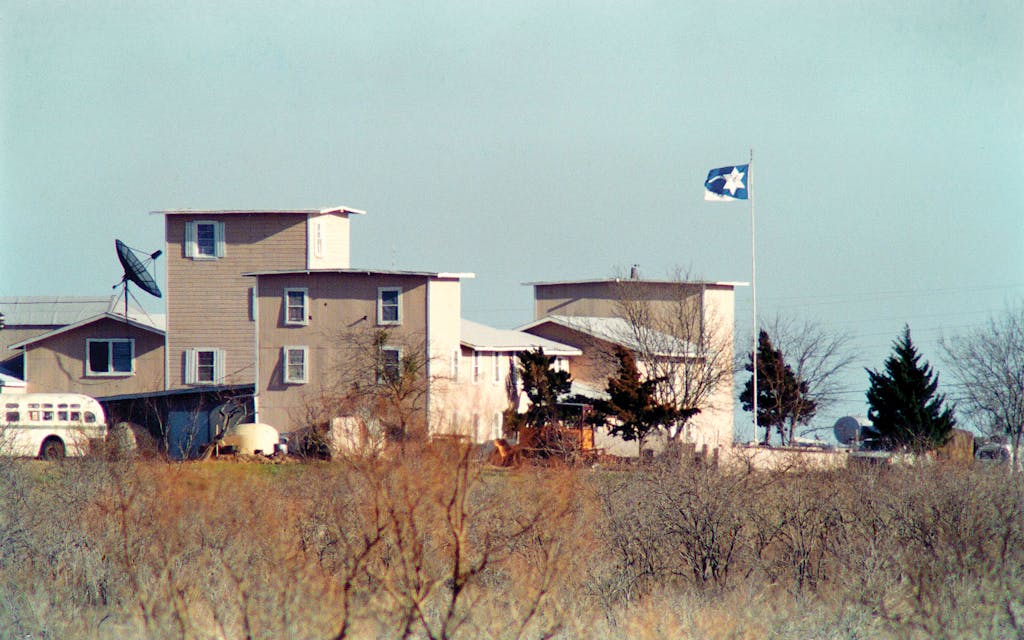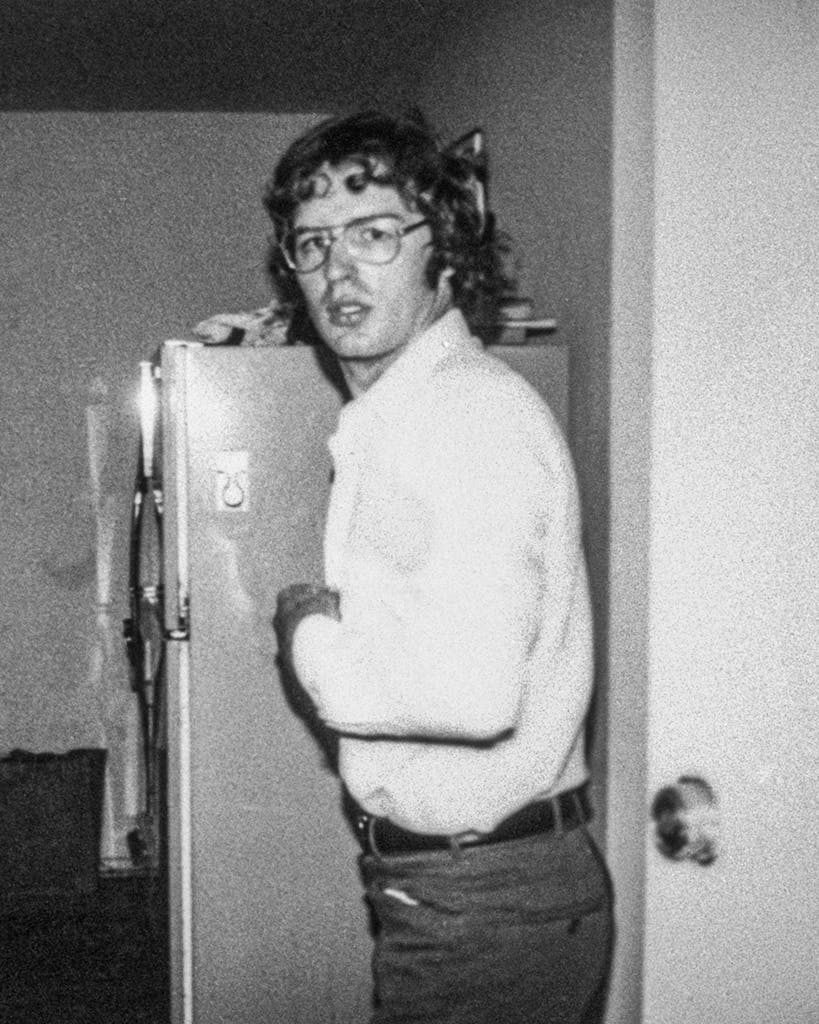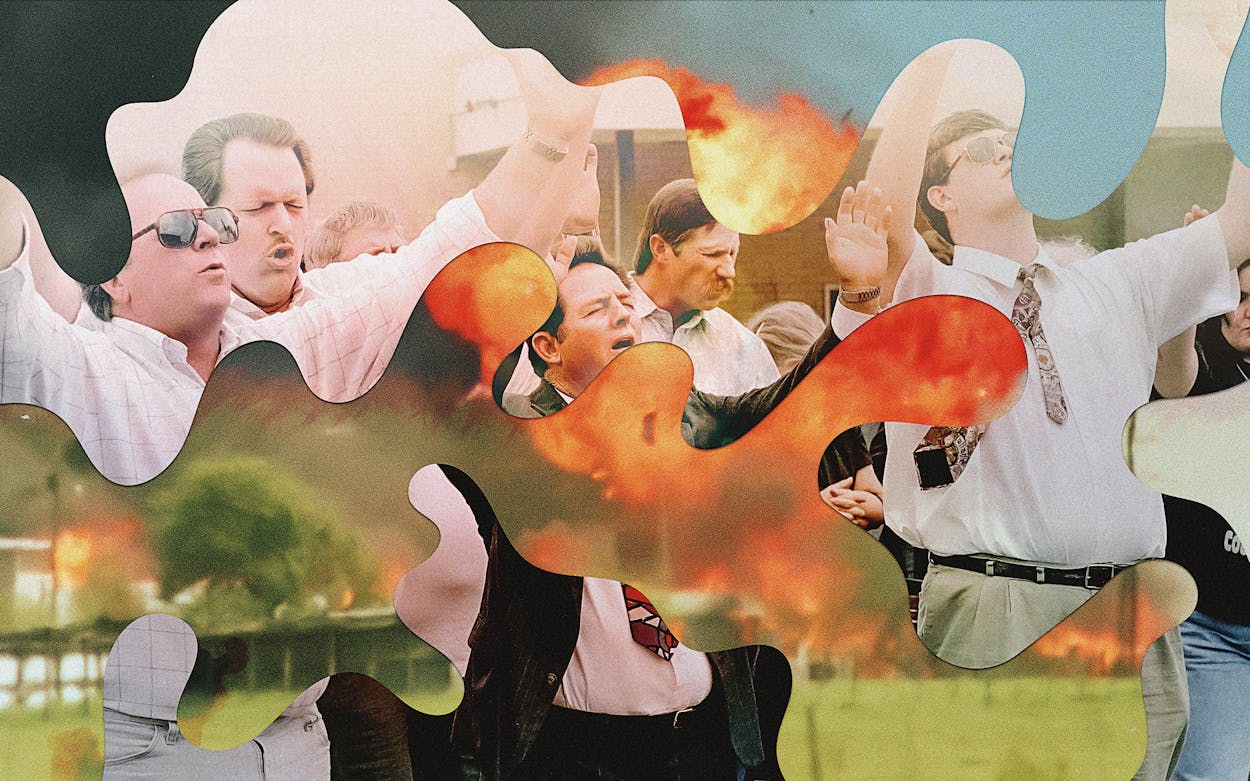One night in the fall of 1869, an angel visited a homeopathic physician in upstate New York named Cyrus Teed. She told him he was the Lamb of God, spoken of in the Bible’s book of Revelation, who was prophesied to open the seven seals and bring about the end-time. This was heady stuff and Teed embraced his destiny. Eventually, he attracted followers, moved with them to a plot of land in rural Florida, and waited for a great fire that would ignite the world in the “grandest pyrotechnic display.” By then, Teed had decided he wasn’t just the Lamb; he was the modern incarnation of another biblical figure, the Persian king Cyrus. He dropped his given name and adopted a new moniker, the Hebrew pronunciation of Cyrus: Koresh.
In 1985, 116 years after the angel visited Teed, seven angels visited an aspiring rock guitarist from Texas named Vernon Howell. They took him up to heaven and told him that he too was the Lamb of God. Like Teed, Howell imagined that he was the modern incarnation of King Cyrus. Like Teed, he waited for Armageddon with a group of followers on a plot of land in the South. And like Teed, he changed his name—to David Koresh.
History doesn’t repeat itself, but, as the adage goes, it often rhymes. And perhaps no event in modern American history rhymes quite so strongly and frequently as the saga of David Koresh, his Branch Davidian followers, and their deadly 1993 standoff with federal officials at their Waco-area compound, Mount Carmel. The resonance of the Waco siege, though, goes far beyond the uncanny similarities between Koresh and Teed, which are described by the Fort Worth journalist Jeff Guinn in his new book, Waco: David Koresh, the Branch Davidians, and a Legacy of Rage (Simon & Schuster).
This year marks the thirtieth anniversary of the siege, and Guinn’s book is one of a trio that try to situate what happened in both the past and the present. But untangling the event known around the world simply as “Waco” is a tricky task because there are so many threads. There’s Waco as a chapter in the story of homegrown religious movements. There’s Waco as a flash point in a centuries-long battle over gun rights, property rights, and the reach of federal law enforcement. There’s Waco as a conspiracy theory, Waco as a cautionary tale about cults.
Does an author, three decades after the event, write a cinematic narrative, a somber history, a biography, an exposé, or a debunking? All these approaches have been tried before. Yet, as it turns out, there are still new facts to uncover and new insights to be excavated—and many of the same old battles to be fought.

Of the three books, Kevin Cook’s Waco Rising: David Koresh, the FBI, and the Birth of America’s Modern Militias (Henry Holt and Company) hews closest to the narrative described by Branch Davidian survivors of the siege, particularly David Thibodeau, Sheila Martin, and the late Clive Doyle, Koresh loyalists who wrote books about their time at Mount Carmel. In Cook’s telling, Koresh is flawed—a “sinful messiah,” in Koresh’s own estimation—but also an inspiring, folksy, and, for a while at least, mostly harmless religious leader. “Just a dude,” in Thibodeau’s words.
The darker accounts of Koresh’s behavior are barely gestured at. Here, when the Branch Davidians paddle their children with wooden spoons to discipline them, it doesn’t leave bruises. When they stockpile secondhand weapons, it’s a savvy business investment to take advantage of soaring prices on the resale market. When 76 Bureau of Alcohol, Tobacco and Firearms agents, alerted to the group’s massive arms stash, arrive at Mount Carmel, Cook goes with Thibodeau’s and Doyle’s recollections of Koresh as a reasonable man. “I want to talk it out with these people,” Koresh says, before heading outside, “so don’t anybody do anything stupid.” A few moments later, some bad apples do just that. “Forgetting Koresh’s command,” Cook writes, “his followers rained bullets on the federal agents outside, who shot back.”
At the same time, Cook, who wrote a widely praised book on New York City’s infamous Kitty Genovese murder, doesn’t see a wild government conspiracy at work. He swats away arguments that the FBI ignited the fire that consumed the compound and that government snipers picked off Branch Davidians on the final day of the siege. And Waco Rising is at its strongest when Cook is both sympathetic and rigorous, particularly in one late section in which he debunks a theory that a sniper in a helicopter killed one of the Davidians in the ATF raid. But there are too few of these moments. More often, Cook stands by as Koresh’s defenders get the last word.
By contrast, the figure portrayed in Stephan Talty’s forthcoming Koresh: The True Story of David Koresh and the Tragedy at Waco (Mariner Books, April 11) is an unambiguous monster, the guy Americans saw on the cover of Time magazine in 1993 cackling in front of flames above the words “His name was Death, and Hell followed with him.” From his first moments at Mount Carmel, Talty’s Koresh is thoroughly debased. In the memory of the former Davidian Debbie Bunds, the first thing Koresh wanted to do was flirt with two twelve-year-old girls. “Okay, so he’s a pervert,” Debbie said to her friend Rachel. Two years later, Koresh took fourteen-year-old Rachel as his bride, having sex with her to seal the union, an act Talty labels as what it was: rape.
It only got more horrific from there. After marrying Rachel, Koresh began preying on other girls. Soon he was marrying multiple teenagers, declaring that all men except for him must be celibate, and impregnating as many of the girls and women as he could.
No one disputes these basic facts. But Talty is out to paint a psychological profile of Koresh that is as much novelistic as journalistic. He writes in the acknowledgments that his book’s technique was inspired by Norman Mailer’s Pulitzer Prize–winning true-crime novel The Executioner’s Song, which occasionally wandered from the known facts into what Mailer dubbed “extrapolation.” In Talty’s book, we frequently enter Koresh’s mind. We hear about the impact of the abuse Koresh alleges happened to him as a boy, when he was going by his birth name, Vernon Howell, which has caused him to become an abuser himself. Talty’s Koresh often spirals into self-loathing.
“After days spent with his depressed thoughts, a special dream would burst into Vernon’s mind,” Talty writes. “God would demand that Vernon obey him. The vision would release him from all responsibility. It gave him permission to do what he’d wanted all along.”
In Talty’s telling, Koresh is motivated not merely by lust or a thirst for power but by sadism. “It was as if having sex with the Davidian wives was just half the thrill for Vernon. He also wanted to humiliate the men, revel in their pain.”
Even if Koresh is best understood as a speculative biography, the book isn’t always on firm ground. Talty’s account of Koresh’s boyhood across Texas is muddled. In one sentence, Koresh is quitting Garland High School after eleventh grade, then a few sentences later he’s age fourteen and being shipped off to live with his grandparents in Tyler. Talty also refers to Dallas, Waco, and Little Elm (which is near Denton) as being in East Texas. None of them are.
Talty’s narrative is stocked with striking details and elaborate dialogue, but he relies heavily on the accounts of apostate Branch Davidians who left the group before the siege and loathed Koresh. Lurid and shocking stories about child abuse and violence are presented as stone-cold fact. You’d have no idea that many of them have been challenged by other Davidians and investigated inconclusively by law enforcement, and that when they were first aired in places like the Waco Tribune-Herald, they were presented as allegations.
Talty has clearly made up his mind: Koresh was a madman. Depicting a frightening exchange between Koresh and a former girlfriend, Talty writes, “Vernon threw his head back and laughed, in a way you could only describe as maniacal.” Perhaps you can only describe a laugh as “maniacal” if you’ve already decided the man doing the laughing was a maniac.

The third of these books, Jeff Guinn’s Waco, takes a different tack than Cook’s or Talty’s, leaning less on the previously published testimonies of one group of Davidians or another and instead trying to answer the question of why anyone would follow Koresh in the first place. Guinn’s book feels the freshest—the facts most thoroughly researched, the many lingering debates explored with the most rigor. He begins with what may be the best account of the ATF raid on Mount Carmel yet written, stocked with new details from interviews with veteran agents and written with clarity and drama.
But Guinn, the author of acclaimed books on Charles Manson and Jonestown, is less interested in the particulars of the Waco siege itself than in the complicated interplay of faith, law, and prophecy that set those events in motion. Guinn starts the clock in 1843, with the failed end-time prediction of the Baptist lay minister William Miller, then tracks a line of would-be prophets, missed apocalypses, and internecine feuds through the establishment of the Branch Davidians at Mount Carmel in the 1960s. Guinn’s tangent on the parallels between the two Koreshes—Cyrus Teed and Vernon Howell—is particularly riveting. Did Howell model himself on Teed?
Guinn isn’t so sure. He learned that a rare copy of Teed’s teachings was available in the Waco–McLennan County Library during Koresh’s time in the area, but the records of who checked out the book are long gone. The parallels between the two men are left as an eerie echo. Yet Teed died in obscurity, while Koresh was destined for an afterlife of infamy. Guinn sets about trying to figure out why that happened.
At the start, in Guinn’s account, Koresh is more the dude that David Thibodeau describes in Cook’s book than the already active predator in Talty’s. This Koresh is something akin to a hip youth pastor, playing guitar, pulsating with energy, and trying to meet people where they were. “His demeanor was so warm, so relatable, that you gratefully absorbed, rather than painstakingly memorized, the lessons, and applied them afterward in all you did,” Guinn writes.
But this Koresh is also obsessed with a war to end all wars; the more he feels threatened, and the more law enforcement closes in, the more dire his prophecies become. Still, Guinn doesn’t see Mount Carmel as a place of depression and terror, as Talty does. He’s fascinated that so many in the group seem so sanguine about their role in the coming Armageddon. For him, what happened at Mount Carmel is less about the power of an abusive cult leader and more a lesson in how zealous faith can warp reality.
“The lives of the Branch Davidians were dominated by one overriding fact,” Guinn writes. “They viewed every facet of their lives, every action taken, every word spoken, from a spiritual rather than secular perspective.” As Guinn sees it, the Davidians weren’t scared of the end of the world. For them, it was an exhilarating time to be alive.
Though when the end did arrive, it was anything but exhilarating. On April 19, 1993, the FBI shot tear gas into the Davidians’ residence, deployed armored vehicles to slowly dismantle the building, and then watched, along with the millions tuning in on live TV, as a fire erupted and ripped through the compound. Fifty-three adults and 23 children were killed.
All three books agree that the siege was an unmitigated law enforcement disaster. The ATF blundered into Mount Carmel with too little intelligence and too much testosterone, and then the FBI repeated those mistakes by hamstringing its able negotiators and turning the operation over to the bureau’s elite tactical team, which treated a fidgety and distrustful religious sect like an enemy battalion in need of being smoked out. But even though the FBI might have made a terrible situation worse, Cook, Talty, and Guinn also give the same answer to the most controversial question of the entire Waco catastrophe: Who started the fire? The Davidians did, they all say, although the different ways they get there are telling.
Talty’s Koresh presents the fire as a case of suicidal arson but argues that Koresh had a clear strategy to kill FBI agents with it as well. Cook initially depicts Koresh, inside the compound, as almost a concerned school principal, walking briskly to investigate reports of a fire rather than helping to set it himself. But Cook ultimately gives the final word on the matter to the religious scholar Kenneth Newport, who believes that the Davidians’ spiritual teachings about being “cleansed by fire” and the discovery of slashed Coleman lanterns presumably used to spread fuel around the building make it highly likely that the Davidians set the fire themselves and that Koresh told them to do it.
Guinn considers the most prominent theories about how the fire could have started—that the government set the fire intentionally, that the government started the fire accidentally, and that the Davidians set the fire deliberately as a mass suicide. Then he endorses a fourth theory: that Koresh ordered the fire to be set—not as a mass suicide but “to create a holy barrier that the FBI’s tanks and gas could not penetrate.” Maybe. But if this was Koresh’s rationale, he was, of course, proved disastrously wrong.
Despite their differences, Cook, Talty, and Guinn agree on one other thing: not only was the Waco siege shaped by many of the most fundamental forces in our past, it has shaped much of what has happened in the decades since. The history hasn’t been repeated, but you can’t ignore the rhymes. All three books recount the tragedy’s most direct fallout—how Timothy McVeigh, a rageful Gulf War veteran, visited Waco for a couple of days during the siege and then, on the second anniversary of the fire, drove a Ryder truck filled with explosives up to the front of the Alfred P. Murrah Federal Building, in Oklahoma City, and lit two fuses. The attack killed 168 people.
But Waco’s influence extends well beyond McVeigh’s mass murder. During the siege, an Austin high school student named Alex Jones grew obsessed with what he saw as a government run amok. A few years later, he launched his career as a public access TV and radio host by promoting fringe theories about Waco. Jones’s conspiracy-addled worldview may not have started at Mount Carmel, but there’s no doubt that what happened there was
an accelerant.
And the fire keeps burning, as demonstrated by the “deep state” conspiracy theories of QAnon and the storming of the U.S. Capitol in 2021. We’re unlikely to be done with this fever any time soon. As the retired Texas Rangers captain David Byrnes says in Guinn’s book, “I see where this is going to be an endless thing.”
This article originally appeared in the March 2023 issue of Texas Monthly with the headline “The Fire That Never Went Out.” Subscribe today.
Image Credits: Fire: Jerry W. Hoefer/Fort Worth Star-Telegram/Tribune News Service via Getty; Prayer: Dave Martin/AP
- More About:
- Books
- David Koresh
- Waco








